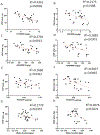Correlation analysis of cartilage wear with biochemical composition, viscoelastic properties and friction
- PMID: 37060715
- PMCID: PMC10175217
- DOI: 10.1016/j.jmbbm.2023.105827
Correlation analysis of cartilage wear with biochemical composition, viscoelastic properties and friction
Abstract
Healthy articular cartilage exhibits remarkable resistance to wear, sustaining mechanical loads and relative motion for decades. However, tissues that replace or repair cartilage defects are much less long lasting. Better information on the compositional and material characteristics that contribute to the wear resistance of healthy cartilage could help guide strategies to replace and repair degenerated tissue. The main objective of this study was to assess the relationship between wear of healthy articular cartilage, its biochemical composition, and its viscoelastic material properties. The correlation of these factors with the coefficient of friction during the wear test was also evaluated. Viscoelastic properties of healthy bovine cartilage were determined via stress relaxation indentation. The same specimens underwent an accelerated, in vitro wear test, and the amount of glycosaminoglycans (GAGs) and collagen released during the wear test were considered measures of wear. The frictional response during the wear test was also recorded. The GAG, collagen and water content and the concentration of the enzymatic collagen crosslink pyridinoline were quantified in tissue that was adjacent to each wear test specimen. Finally, correlation analysis was performed to identify potential relationships between wear characteristics of healthy articular cartilage with its composition, viscoelastic material properties and friction. The findings suggest that stiffer cartilage with higher GAG, collagen and water content has a higher wear resistance. Enzymatic collagen crosslinks also enhance the wear resistance of the collagen network. The parameters of wear, composition, and mechanical stiffness of cartilage were all correlated with one another, suggesting that they are interrelated. However, friction was largely independent of these in this study. The results identify characteristics of healthy articular cartilage that contribute to its remarkable wear resistance. These data may be useful for guiding techniques to restore, regenerate, and stabilize cartilage tissue.
Keywords: Cartilage; Collagen; Crosslinks; Friction; Glycosaminoglycans; Pyridinoline; Viscoelastic; Wear.
Copyright © 2023 Elsevier Ltd. All rights reserved.
Conflict of interest statement
Declaration of competing interest The authors declare the following financial interests/personal relationships which may be considered as potential competing interests: Diane Wagner reports financial support was provided by National Institutes of Health.
Figures









Similar articles
-
Anisotropic properties of articular cartilage in an accelerated in vitro wear test.J Mech Behav Biomed Mater. 2020 Sep;109:103834. doi: 10.1016/j.jmbbm.2020.103834. Epub 2020 May 1. J Mech Behav Biomed Mater. 2020. PMID: 32543401 Free PMC article.
-
Mechanical Wear of Degraded Articular Cartilage.Ann Biomed Eng. 2025 Apr;53(4):956-965. doi: 10.1007/s10439-025-03680-8. Epub 2025 Jan 25. Ann Biomed Eng. 2025. PMID: 39863807
-
Biomechanical and biotribological correlation of induced wear on bovine femoral condyles.J Biomech Eng. 2009 Jun;131(6):061005. doi: 10.1115/1.3116156. J Biomech Eng. 2009. PMID: 19449959
-
Cartilage Integrity: A Review of Mechanical and Frictional Properties and Repair Approaches in Osteoarthritis.Healthcare (Basel). 2024 Aug 19;12(16):1648. doi: 10.3390/healthcare12161648. Healthcare (Basel). 2024. PMID: 39201206 Free PMC article. Review.
-
Friction in soft biological systems and surface self-organization: the role of viscoelasticity.Biophys Rev. 2024 Oct 28;16(6):813-829. doi: 10.1007/s12551-024-01248-9. eCollection 2024 Dec. Biophys Rev. 2024. PMID: 39830128 Free PMC article. Review.
Cited by
-
Immature bovine cartilage wear is due to fatigue failure from repetitive compressive forces and not reciprocating frictional forces.Osteoarthritis Cartilage. 2023 Dec;31(12):1594-1601. doi: 10.1016/j.joca.2023.08.008. Epub 2023 Aug 24. Osteoarthritis Cartilage. 2023. PMID: 37633593 Free PMC article.
-
Key roles of the superficial zone in articular cartilage physiology, pathology, and regeneration.Chin Med J (Engl). 2025 Jun 20;138(12):1399-1410. doi: 10.1097/CM9.0000000000003319. Epub 2024 Oct 23. Chin Med J (Engl). 2025. PMID: 39439390 Free PMC article. Review.
-
A major functional role of synovial fluid is to reduce the rate of cartilage fatigue failure under cyclical compressive loading.Osteoarthritis Cartilage. 2025 Jan;33(1):94-100. doi: 10.1016/j.joca.2024.08.008. Epub 2024 Aug 28. Osteoarthritis Cartilage. 2025. PMID: 39209247
References
-
- Accardi M, 2013. Numerical and experimental characterisation of articular cartilage: a study on biomechanics and biotribology, osteoarthritis and tissue engineering solutions.
-
- Ateshian G. a, Mow VC, Huiskes R, 2005. Friction, lubrication, and wear of articular cartilage and diarthrodial joints. Basic Orthop. Biomech. Mechano-Biology 10.1186/1475-925X-4-28 - DOI
Publication types
MeSH terms
Substances
Grants and funding
LinkOut - more resources
Full Text Sources

